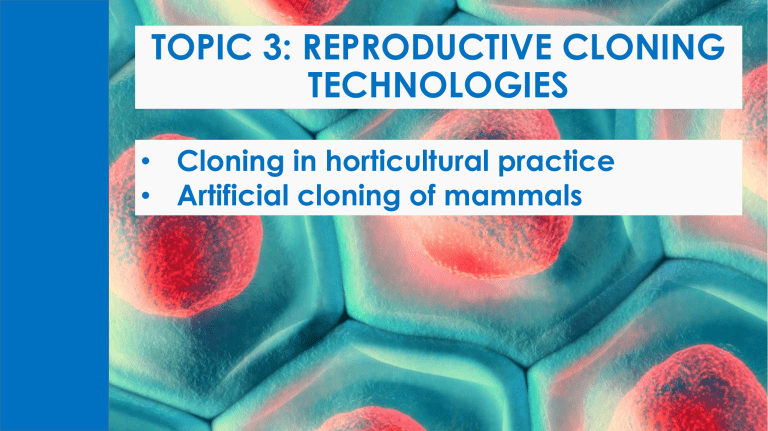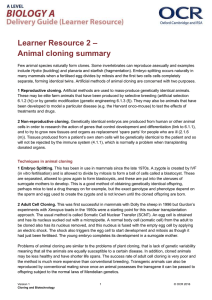
TOPIC 3: REPRODUCTIVE CLONING TECHNOLOGIES • Cloning in horticultural practice • Artificial cloning of mammals CLONING • Embryo Splitting • Nuclear Transfer • Application of Cloning CLONING: WHAT IS IT? Definition: the process of making an identical copy of an original. There are different types of cloning procedures: • Cloning in horticultural practice • Artificial cloning of mammals: • Embryo splitting to make identical copies • Somatic cell nuclear transfer (SCNT) CLONING in horticultural practice Plant tissue culture technology in the lab identical copies of a plant Examples: ornamental plants (orchids), native plants (eucalyptus) ADVANTAGES: • Slow growing plants produced in large numbers • Plants cultured year round in controlled conditions • Virus free tissue can be used • Cultured plants transported from country to country CLONING in horticultural practice STEPS: 1. Plant with desirable characteristics selected 2. Pieces are selected with meristematic tissue Can be done using: • whole organisms, • Tissue samples or • even a single cell CLONING in mammals EMBRYO SPLITTING Cells of an early embryo artificially separated into two cell masses Mimics natural process of identical twins Embryo features: • Parents chosen due to desirable characteristics • Embryos produced through in vitro fertilisation • Fine glass needle splits embryo at early stage of development • Each embryo is implanted into uterus of surrogate female parent BIOLOGICAL CLONING: EMBRYO SPLITTING 1. Egg cells are removed from the donor female and fertilised in vitr o by a sperm from the male. 2. After the fertilised egg has divided, the coat around the cells that promotes cell division is removed and the two cells are separated. 3. Each cell is then given an artificial coating that promotes cell division, allowing for the differentiation of embryos. 4. These embryos are then implanted into surrogate mothers. CLONING in mammals Embryos • not identical to either parent • Only identical to each other • Identical copies of the fertilized egg CLONING in mammals SOMATIC CELL NUCLEAR TRANSFER (SCNT) Cells and their nuclei are manipulated using SCNT a) The nucleus of a cell is removed creating an enucleated cell b) The nucleus of another cell can be transferred to an enucleated cell to form a redesigned nucleated cell c) An enucleated cell can be fused with a somatic cell using a short electrical pulse. CLONING in mammals BIOLOGICAL CLONING: NUCLEAR TRANSFER 1. Nucleus collected from adult somatic cell 2. Unfertilised egg cell is enucleated 3. Fusion of nucleus and donor egg 4. Implantation of embryo to surrogate mother 5. Development & birth of organism with identical genotype to adult from step 1. CLONING in mammals SOMATIC CELL NUCLEAR TRANSFER (SCNT) Genetic information comes from nucleus of adult body cell so genotype of cloned animal determined by donor nucleus, not the egg into which the nucleus is transferred. THE DOWNSIDE: • Success rate in initiating development of the egg cell after transfer of the donor nucleus is low • High levels of developmental abnormalities CLONING: APPLICATIONS TO AGRICULTURE • Animal cloning is used to increase the number of breeding animals with naturally occurring desirable traits. • Plants are “cloned” from cuttings in order to have the exact same desirable characteristics that may not appear in seed offspring. However, this can also leave plants with a lower genetic diversity and more vulnerable to pests and disease infestation. • Cloning can also be used to conserve rare or endangered plant species, such as the Wollemi Pine, which was thought to be extinct and dates back to an existence of 110 million years ago. CLONING in mammals SAMPLE PROBLEM: • Scientists took tissue from three cattle that they believed had been created through a cloning process. The cattle all had identical genomes; however, their genome was not identical to the mother who provided her genetic material via her eggs. What type of cloning has been used to create the three cattle? (3 marks)





